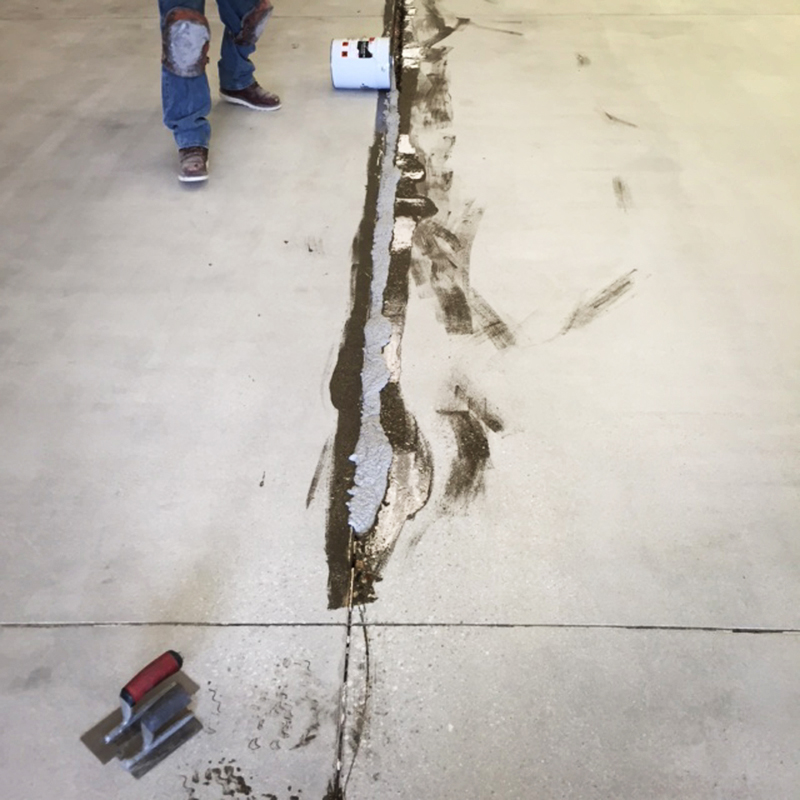When random tiles in South El Monte High School’s 11,300-sf “cafeteria-um” started popping up, the flooring started creating trip hazards. So department workers simply replaced the tiles. That didn’t work.
As the operations manager for Sunbelt Flooring in Chino, Calif., Chris Kelly has seen the moisture-beneath-the-surface tiling issue before. Working with CJ Knowland, a project engineer for Construct 1 in Tustin, Calif., Kelly assessed the damage. After 15 to 20 years of cleaning that floor, detergents and degreasers used by various cleaning crews seeped into the joints of the VCT soaking them, eventually creating a layer of contamination.
After testing the slab, they found the existing concrete slab had extremely high moisture levels. This moisture kept pushing the cafeteria-um’s VCT up, which caused tiles to pop. It created costly repairs and trip hazards, especially in one area, which Kelly mentioned had been repaired multiple times.
“I don’t think anybody knew that crack – as big as it was – was there,” Kelly says. “When you have a large, wide open structural crack, moisture takes the path of least resistance to the closest opening. They were having issues over the top of that crack. There was so much glue packed down there from times it had been repaired, it was hard to see until we shot-blasted the floor.”

After shot-blasting, they performed a water penetration test. “This helped assure that we get the proper penetration rate for our materials,” Kelly says. “No concrete is the same, so this is actually a very important step that we take.”
To ensure the slab would be free of moisture concerns, Sunbelt turned to AC Tech’s 2170, 100-percent reactive solids, tested to contain ZERO VOC emissions and almost no detectable odor, ideal for sensitive and soon-to-be-occupied areas.
Sunbelt removed all unsound concrete in the big structural crack, and then poured silica thickened AC Tech 2170 into the joints. They reinforced it with 2170 FC resin that was saturated into heavy mesh fiberglass. The 2170 and 2170 FC saturated in the woven fiberglass is used to displace the movement of the joints. Kelly stated, “If you don’t fill the joints with the AC Tech product itself, the moisture will find the joint and push out the filler, thus causing a failure. Standard epoxy is not designed to withstand what this slab had in moisture.”
Knowland said, “The AC Tech product was able to provide a 15-year warranty. It provided the solution to our moisture issues and the owner was very pleased with the end results.”
“Sunbelt is a reputable and professional flooring contractor,” says Dawn R. Parnoff, executive VP, AC Tech. “They don’t cut corners. We trust them; we never have to worry when they are on the job. It is the best-case scenario – the right company and right product equals success.”
South El Monte High School got its cafeteria-um back without the constant need to keep replacing tiles. “There is a bit of sticker shock when you need to make an investment like this, so it was a hard pill to swallow for the school district,” Kelly says. “That’s why it is so important to use right product.”
Related Stories
| Aug 11, 2010
LEED 2009 cites FloorScore Certification as indicator of indoor air quality
The U.S. Green Building Council (USGBC) has cited FloorScore® certified flooring products as eligible for credits under the new LEED 2009 Version 3 guidelines. Reflecting the inclusion of FloorScore, the new LEED IEQ Credit 4.3 for Low-Emitting Materials has been expanded from “Carpet Systems” to “Flooring Systems” to include hard surface flooring.
| Aug 11, 2010
Best AEC Firms of 2011/12
Later this year, we will launch Best AEC Firms 2012. We’re looking for firms that create truly positive workplaces for their AEC professionals and support staff. Keep an eye on this page for entry information. +







